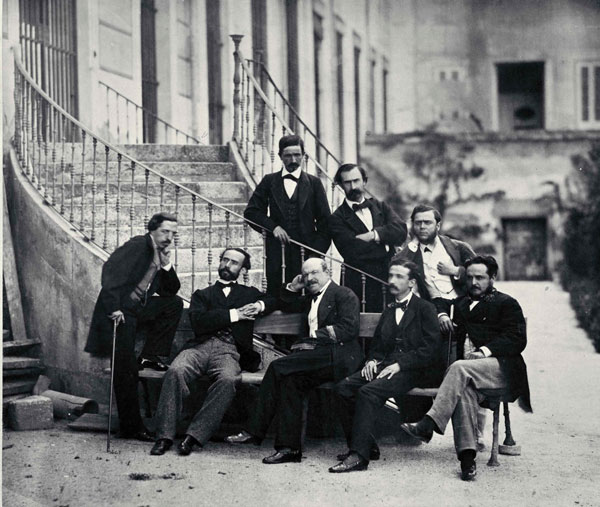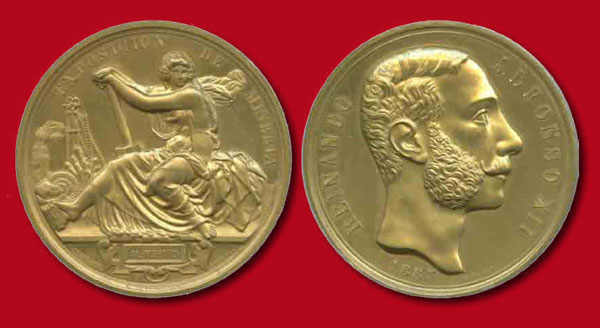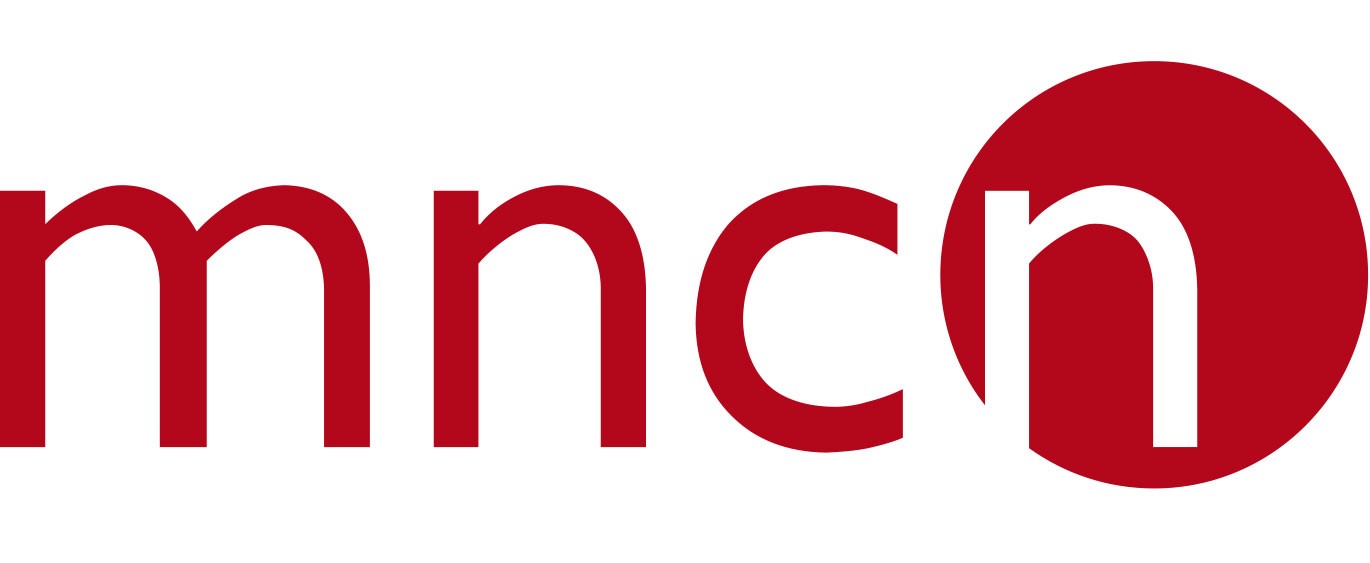Second era (1815-1900)
Finished the Independence War in 1814, the King Ferdinand VII regained the Spanish throne. In 1815, with the purpose of unify the teachings of the Natural Sciences, it was founded the Royal Museum of Natural Sciences, institution composed by the Royal Cabinet of Natural History, the Royal Botanic Garden, the Mineralogy Studio and the Chemistry Laboratory. One year later, it will be added the Astronomic Observatory.
In that same year (1815), it was redacted the first Museum regulation and it was headed by a protector, the Minister of State. The protector was assisted by a deputy protector, five professors, five vice-professors and four curators. For years the centre was without a director. It went from being managed by a Board of Protection to being directed in 1837 by a Governing Board made up of university professors. This situation was in line with the important administrative innovation that took place in 1822, when the Museum acquired a fully university profile when it was attached to the Central University of Madrid, founded in the same year.

In 1845, the Museum started to depend of the Philosophy Faculty and it's teachings make part of the Spanish educative politics. It administrative director, later, was the interim professor of zoology Mariano de la Paz Graells. He was subordinate to the university authorities. Under his 23-year term of office, very notable progress was made: work was done to organise and increase the scientific collections and research was stepped up. Scientific expeditions are also promoted, such as the one organised to the Americas, the Pacific Scientific Commission (1862-1865), the travels of the palaeontologist Juan Vilanova y Piera, or the participation in the Commission for the Geological Map of Spain.
The Pacific Scientific Commission (1862-1865) was especially important to be the first scientific expedition that includes in one of it's members a photographer, Rafael Castro Ordóñez, which made it possible to graphically document what America was like in the 19th century. Ordóñez photographed everything from cities, landscapes, portraits of people of different social classes and races to strategic installations such as ports, customs, farms and mines. Nearly 300 negatives and 138 albumen prints are preserved in the Historical Archive of the National Museum of Natural Sciences.
In addition to this photographic material, the five Spanish naturalists that were in the expedition, Patricio María Paz y Membiela, Fernando Amor y Mayor, Francisco de Paula Martínez y Sáez, Marcos Jiménez de la Espada, Manuel Almagro y Vega, and Juan Isern y Batlló, sent more than 80.000, anthropological and ethnographic, fauna and flora samples. After their studies led to the discovery of new species. They left the port of Cadiz on August 10th, 1862 and arrived in the Brazilian port of Bahia on September, 9th to travel through Brazil, Uruguay, Argentina, Chile and Ecuador, even going as far as California. The Commission was officially disbanded in January 1866.
This and other scientific expeditions resulted in a significant increase in the number of specimens in the Museum's collections and a fluid exchange with other institutions. Graells ensured that the entire collection of the Royal Cabinet was catalogued. The task took two decades and a great effort to complete. Even so, much of the museum's collection remained in unopened boxes due to a lack of staff and funding.
Graells's project, the Zoological Acclimatisation Garden, installed in the Royal Botanical Gardens, was born with the aim of breeding new species with which to increase the supply of meat for the population. Animals were brought from America (guanacos, maras, coypu, chinchillas, black swans...) which populated the gardens of the Botanical Gardens, along with other existing fauna. With his dismissal as director, the project was discontinued and the animals were transferred to the zoo located in the Retiro Gardens.
In 1867 the museum collection was split up. The ethnographic pieces and antiquities were sent to the recently created National Archaeological Museum, part of which would later be transferred to the Museum of America when it was founded in 1941. This was the first of the divisions of its collection, as it also provided pieces to other museums and institutions such as the Prado Museum, the National Library, the National Museum of Decorative Arts, the Costume Museum and the National Museum of Anthropology.
Mariano de la Paz Graells was replaced as director in 1868 by Lucas de Tornos Usaque, a student of his. The post depended on the rector of the University and was advised by a Board of Professors. During his term of office, in 1871, the Sociedad Española de Historia Natural (SEHN) was created, a private scientific society - the first in Spain - in which several naturalists linked to the Museum participated. The Museum's close collaboration with the SEHN was a great stimulus for the advancement of the natural sciences in Spain by collaborating with other national and foreign centres, organising scientific expeditions and training naturalists. Its bibliographic collection of books and journals covered all branches of the natural sciences (some of whose titles were unique in Spain) and its publications, of great scientific prestige, were a point of reference for the scientific community. Thanks to the beneficial influence of the SEHN, the doors of the Museum, which had been closed for years, were reopened.
The Museum took part in the Universal Exhibition held in Paris in 1878. Although Spain had not missed any of the previous major universal exhibitions held in London, Paris and Vienna, its presence had not been very significant. However, at the 1878 exhibition, a Spanish pavilion with a Mudejar-style front was designed to house the objects of the numerous public and private institutions that took part. The Museum exhibited three skulls and a photograph of a Guanche mummy. The Pacific Commission exhibited thirty skulls of American Indians, an embalmed Guaraní Indian head, eight mummies of Indians from Peru and Bolivia, two hammocks, ten arrows, three blowguns, a bow, a shield, a buckler and various pieces of clothing and ornaments of Guaraní Indians, canelos, záparas, aguaricos, yaguas, etc., as well as publications written by members of the Commission on molluscs and reptiles.
Five years later the Museum also took part in another important exhibition, the Exposición Nacional de Minería, Artes Metalúrgicas, Cerámica, Cristalería y Aguas Minerales (National Exhibition of Mining, Metallurgical Arts, Ceramics, Glassware and Mineral Waters) in 1883, inaugurated by King Alfonso XII. He was awarded several prizes in different categories, including the Gold Medal of Merit for the exhibition of his mineral collection. This medal is currently kept in the Fine Arts Collection of the National Museum of Natural Sciences.
The Museum continued to collaborate with other centres, such as the Estación de Biología Marina de Santander, created in Cantabria in 1886. It was the first institution dedicated to the marine biology, to study the oceanic and coastal marine flora and fauna of the Cantabrian Sea, which at that time were little known. In addition to its research, this Station was to promote marine biology studies and train researchers, collaborate in the progress of industries associated with the exploitation of marine resources and increase the collections of museums and teaching centres with specimens, one of which was the National Museum of Natural Sciences. From 1901 to 1914 this institution, founded by Augusto González de Linares, was attached to the Museum.

In 1892, Lucas de Tornos Usaque died and was replaced by the geologist Miguel Maisterra Prieto. That year, Salvador Calderón y Arana was commissioned to travel around Europe to learn about the organisation and functioning of the great natural history museums, in the hope that the Madrid-based Gabinete could be modernised. Calderón presented a project for a centre that was still short of funding, space and a remodelling that would bring it up to the level of other natural science museums, such as those in London or Paris. It was not to be.
In the other hand, in 1895, through one Royal Order, the Minister of Public Works Alberto Bosch y Fuster ordered the transfer of the Museum from its original site in Calle de Alcalá to a new one in the Palace of the Library and National Museums on Paseo de Recoletos (now the National Library/National Archaeological Museum) in order to provide it with a better location. The free space left by the Museum was to be occupied by the Ministry of Finance.
Despite of the protests of scientists, university professors and intellectuals of the time, the entire museum collection had to be moved in 48 hours and deposited in the basement of the building, with no conditions for the conservation of the pieces and with serious damage, due to the haste with which the move was made. Not all the scientific collections arrived at the Palace; the insect collection and the Anthropology section, for example, were deposited in the Museum of Dr. Velasco, today the National Museum of Anthropology.
In 1897, two years after the loss of the Museum's building and due to the death of the previous director, Tomás Andrés y Andrés Montalvo was appointed and held the post for three years. With the arrival of the 20th century, the Museum entered a new period of resurgence and magnificence.
Text from Carolina Martín Albaladejo and Ana García Herranz





